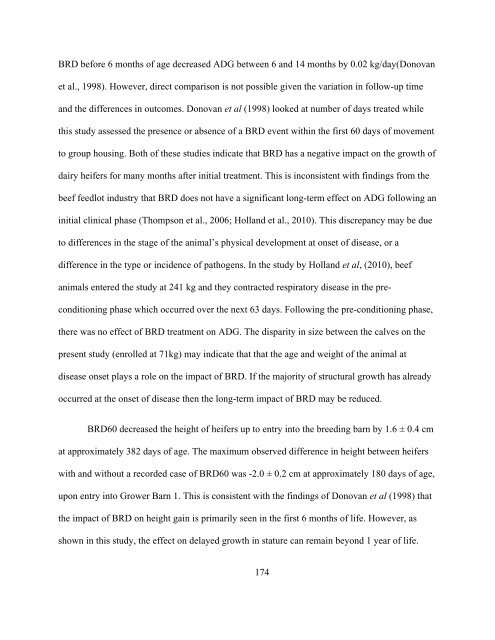Stanton PhD Thesis final_docx - Atrium - University of Guelph
Stanton PhD Thesis final_docx - Atrium - University of Guelph
Stanton PhD Thesis final_docx - Atrium - University of Guelph
You also want an ePaper? Increase the reach of your titles
YUMPU automatically turns print PDFs into web optimized ePapers that Google loves.
BRD before 6 months <strong>of</strong> age decreased ADG between 6 and 14 months by 0.02 kg/day(Donovan<br />
et al., 1998). However, direct comparison is not possible given the variation in follow-up time<br />
and the differences in outcomes. Donovan et al (1998) looked at number <strong>of</strong> days treated while<br />
this study assessed the presence or absence <strong>of</strong> a BRD event within the first 60 days <strong>of</strong> movement<br />
to group housing. Both <strong>of</strong> these studies indicate that BRD has a negative impact on the growth <strong>of</strong><br />
dairy heifers for many months after initial treatment. This is inconsistent with findings from the<br />
beef feedlot industry that BRD does not have a significant long-term effect on ADG following an<br />
initial clinical phase (Thompson et al., 2006; Holland et al., 2010). This discrepancy may be due<br />
to differences in the stage <strong>of</strong> the animal’s physical development at onset <strong>of</strong> disease, or a<br />
difference in the type or incidence <strong>of</strong> pathogens. In the study by Holland et al, (2010), beef<br />
animals entered the study at 241 kg and they contracted respiratory disease in the pre-<br />
conditioning phase which occurred over the next 63 days. Following the pre-conditioning phase,<br />
there was no effect <strong>of</strong> BRD treatment on ADG. The disparity in size between the calves on the<br />
present study (enrolled at 71kg) may indicate that that the age and weight <strong>of</strong> the animal at<br />
disease onset plays a role on the impact <strong>of</strong> BRD. If the majority <strong>of</strong> structural growth has already<br />
occurred at the onset <strong>of</strong> disease then the long-term impact <strong>of</strong> BRD may be reduced.<br />
BRD60 decreased the height <strong>of</strong> heifers up to entry into the breeding barn by 1.6 ± 0.4 cm<br />
at approximately 382 days <strong>of</strong> age. The maximum observed difference in height between heifers<br />
with and without a recorded case <strong>of</strong> BRD60 was -2.0 ± 0.2 cm at approximately 180 days <strong>of</strong> age,<br />
upon entry into Grower Barn 1. This is consistent with the findings <strong>of</strong> Donovan et al (1998) that<br />
the impact <strong>of</strong> BRD on height gain is primarily seen in the first 6 months <strong>of</strong> life. However, as<br />
shown in this study, the effect on delayed growth in stature can remain beyond 1 year <strong>of</strong> life.<br />
174

















